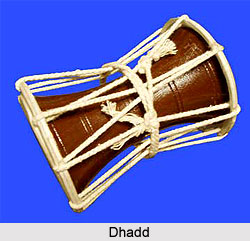 Dhadd is a traditional instrument popular in the Punjab state of India. It is also known as Dhad or Dhadh and is used for Punjabi folk music. This instrument happens to be quite prominent and is typically shaped like an hourglass and is used by the Dhadi singers. Apart from Dhadi singers, this instrument is also used by other folk singers of the region.
Dhadd is a traditional instrument popular in the Punjab state of India. It is also known as Dhad or Dhadh and is used for Punjabi folk music. This instrument happens to be quite prominent and is typically shaped like an hourglass and is used by the Dhadi singers. Apart from Dhadi singers, this instrument is also used by other folk singers of the region.
Designs of Dhadd
Dhadd is traditionally made of wood and is designed in the shape of hourglass. The skin of the instrument on both sides is tightened with ropes that actually help in holding the instrument firmly either vertically or horizontally. Its design is quite similar to various popular Indian musical instruments namely Udukai and Idakka. Dhadd is also similar to Damru with little difference. The Damru has knotted cords stuck to its both sides but Dhadd does not have any chord. Although the design is much similar but techniques of playing, the social implication and music capabilities are entirely diverse.
Playing of Dhadd
Dhadd is played by tapping of fingers on one of its side and as being played by hand, it gives much more precise control over the rhythm rather than Damru. On the other hand, the Damru is played by quickly rotating the drum in such a way that the knotted chords strike the heads. As such, it may be considered to be more of a noise-maker than a serious musical instrument. Hence, Dhadd due to its sophistication elevates to the status of a true musical instrument.
Social Significance of Dhadd
The social significance of Dhadd is quite rich. It is closely associated with and mostly used by the Dhadi singers. Dhadis are distinct group/ singers emerged in the time of Sikh gurus. In English, the word `Dhadi` can be translated as minstrel or bard. According to folks, the Dhadis have a history of hundred years. The Dhadi singers` sing traditional ballads of brave warriors and heroes drawn from history using Dhadd along with Sarangi. Traditional musical instruments like Dhadd hold historical importance thus; the Punjab Cultural Society is training the youth of Punjab in folk music and dance so that they can keep their culture and tradition alive.




















